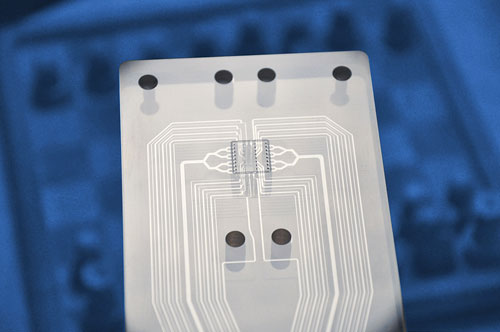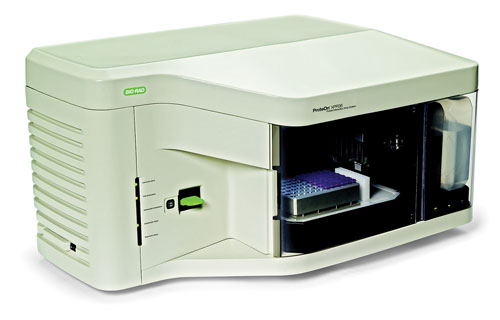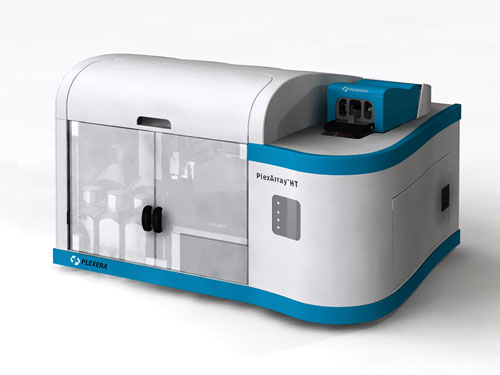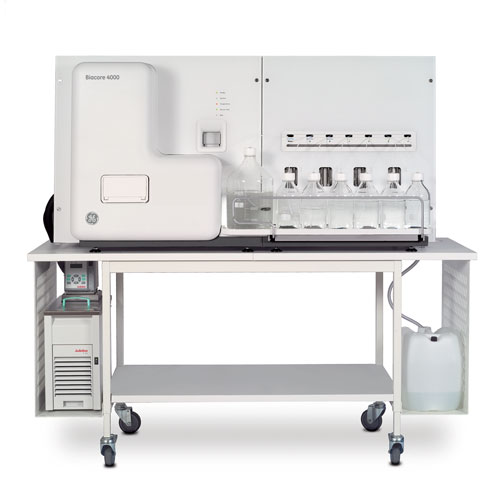February 15, 2011 (Vol. 31, No. 4)
Workhorse Label-Free Drug Discovery and Development Tool Tackles New Applications
With its unique capacity for label-free, real-time generation of detailed information on binding interactions, surface plasmon resonance (SPR) has established itself as a mainstay in drug discovery research. Long-time market incumbents and newer SPR instrumentation suppliers alike are addressing the demand for increases in throughput and expanded range of application.
The standard technology involves a chip or cartridge, on which rest immobilized ligands of interest and below which is a prism. A solution is passed over the chip, and light is shone through the prism at a constant angle.
As the assay solution passes over the chip, temporal ligand-target binding events (as well as binding events with nontarget molecules) result in increases in the molecular weight at the binding points. The target (or other) molecule will dissociate from the ligand according to its own dissociation kinetics.
The temporary changes in mass in turn effect shifts in the angle of light refracted through the prism, which is visually recorded in a “sensorgram”. Computer-aided analysis of sensorgrams renders precise quantitative information about the ligand, target, and interactions between them, for applications in protein and DNA interactions, monoclonal antibody identification, drug-lead evaluation, optimizing purification methods, and even drug formulation and production. As always in the bioindustry, throughput is critical.
Throughput, Sensitivity, Accessibility
Yet “the big issue, even with throughput, is the complexity and subsequent bottleneck in assay development. There are few options for simple systems that can both run and develop assays in a high-throughput manner,” says Christopher Whalen, CEO of Sierra Sensors.
“Along with throughput, there has been relatively little in the way of breakthroughs in detection sensitivity such that small molecule analysis can become more routine.”
Sierra Sensors recently acquired an SPR detection technology from Agilent Technologies that Sierra is developing into what it calls SPR+. The SPR+ detection will be the foundation of a new, “higher throughput, high performance” label-free analysis platform dubbed the MASS-1 (Molecular Affinity Screening System), that Sierra Sensors plans to launch in mid-2011.
The MASS-1 will have eight channels and 16 sensors, enabling the simultaneous analysis of eight samples. The SPR+ detection technology will offer 10- to 100-log improvement in the low-end detection sensitivity of SPR, according to Whalen, to allow for analysis of small molecule binding events “in a much more robust manner.”
In the last few years, Sierra Sensors has also demonstrated its Hydrodynamic Isolation™ (HI) continuous flow, microfluidic sample-delivery technology. HI was designed to enable simultaneous addressing of multiple sample solutions to individual locations on a 2-D sensor array, with all samples delivered as discrete volumes in a continuously flowing assay-buffer stream.
With sensitivity and flow-based throughput, label-free analysis (that is, SPR) could then be applied to true secondary screening (as opposed to simply rerunning confirmatory primary screens of initial hits) and tertiary screening.
“Many of our customers would like to do true secondary screens, where they look either at different targets or different parameters of the primary-screen binding event. Secondary screens using label-free technology will permit qualitative and quantitative screening of compounds with detailed kinetics data, such that off-rates could be ranked very early in the screening process,” Whalen notes. “Researchers can then isolate only those compounds that meet their requirements. This is true quantitative screening.”
Accessibility of SPR technology, which has traditionally been quite costly, is also something companies like Sierra Sensors are tackling. “Academic researchers and smaller labs are often looking for basic, desktop instruments and cannot afford the top-of-the-line equipment. They simply want to do benchtop label-free assays cost-effectively and without much difficulty,” says Whalen.
Sierra Systems’ fully automated SPR-2 instrument is designed to address this market, with a two-channel SPR system that provides “high-performance SPR in a low-throughput platform.” For groups focused on analysis of cells, membranes, and crude samples, Sierra offers its QCMA-1 analysis system, based on the company’s quartz crystal microbalance detection technology.

Hydrodynamic Isolation (HI™) is Sierra Sensors’ continuous flow, microfluidic sample delivery technology. HI combines hydrodynamic focusing with location-specific cell evacuation to create a high-performance continuous flow sample addressing method that is reportedly robust, flexible, and simple to multiplex.
Quality Is Key
As SPR instrument suppliers acknowledge, throughput cannot come at the expense of information quality.
“Researchers see value in SPR because it yields richer kinetic data earlier on in the process than with traditional end-point assays,” says Ariel Notcovich, R&D manager for Bio-Rad Laboratories’ protein function and lab separations divisions. “The further upstream that researchers can get this information from a technology, the earlier they can make good decisions regarding their molecules of interest.”
To this end, Bio-Rad is developing new chemistries to improve existing workflows on its ProteOn™ XPR36 protein-interaction array system. The instrument’s 6-x-6 fluidics are designed to enable 36 interactions to be measured simultaneously, “which opens up new possibilities to SPR users in terms of assay design,” Notcovich says.
With software and hardware improvements in the works to target higher throughput and new applications, Bio-Rad intends that these new workflows will facilitate the use of SPR technology, with “faster experiment setup and protocol validation, improved back-end speeds, and simplified navigation and use of analysis tools and reporting.”
“A move toward high-throughput instrumentation and software platforms that can perform multiple types of analyses from a single sample is where SPR is headed. The major advantage will be good-quality results that allow reliable quantitative validations, ranking, and screening of molecules without compromising throughput.”

The ProteOn XPR36 instrument from Bio-Rad Laboratories reportedly measures the full kinetic parameters of 36 biomolecular interactions simultaneously, and is used by pharmaceutical and biotech companies for the validation, ranking, and screening of drug candidates.
Planar Arrays
Plexera’s approach to throughput incorporates high-density arrays “theoretically designed to accept up to 5,000 spots in an active window of 14 mm by 14 mm,” explains the company’s president, Jay Smith. “We are routinely achieving 1,000 or 2,000 spots in that window and have requests from some of our big pharma customers for 10,000 spots, for DNA-based label-free detection applications.” Between 1 and 36 spots is common for typical SPR platforms.
Plexera has achieved these throughput gains by means of a planar array, in its PlexArray™ HT SPR system, which the company will officially launch at the Society for Biomolecular Screening meeting in Orlando next month.
“We don’t use cartridges, per se, but an off-the-shelf microscope-slide format that end-users can manipulate as they require with the addition of a protein printer. With our platform, researchers have full flexibility to print whatever they want to print onto a gold slide. Plexera then has a patented device that creates a liquid flow cell over the printed area,” Smith explains.
“The slide array is inserted into a special holder in the instrument with an inlet and outlet; we have essentially created a flow cell that works on a planar array. This differs from the network of capillaries in a typical SPR cartridge and affords many-fold gains in throughput. In addition, Plexera’s chip and instrument combination affords broad flexibility in assay and experiment design, which open new avenues to research and assay development. We are developing additional slide technology to further expand the applications for the system.”
Plexera acknowledges the applicability of SPR across the drug development process and aims to offer technologies for applications from “target selection/biomarker identification, target characterization and validation, proof of concept, and clinical safety and efficacy,” Smith notes.
“In the U.S. marketplace, at least, drug discovery and development companies are starting to use SPR in all of the steps of their processes. Even drug manufacturers are starting to use SPR to identify biologically active ingredients, such as oxidative states of certain proteins, that are unwanted in the manufacturing process.”

Plexera’s PlexArray™ system is a high-throughput and label-free biomolecular interaction detection system based on SPR technology. The system utilizes the printing of proteins on specialized surface chemistries, automated array processing, dedicated reagents, and data-analysis software.
From Lab- to Commercial-Scale
Biacore, which has been part of GE Healthcare since 2006, has long been a global market leader in SPR instrumentation. The company’s platforms span a breadth of lab- to commercial-scale applications, with accordingly varying capacities for automation.
In 2010, Biacore launched the Biacore™ T200, which it says builds on the sensitivity of its flagship Biacore T100 platform, to enable analysis of smaller compound interactions requiring lower protein concentrations, while “extending the space of measurable kinetic rate constants,” according to the company.
In 2010, Biacore also launched the Biacore 4000 instrument, which operates in either high-throughput or high-data-content modes, for flexibility in higher throughput applications. The Biacore X100 is the company’s basic, desktop instrument.
Biacore systems and other SPR technologies are increasingly being used or adapted, for instance, in the area of food safety and quality assurance. As just two examples, Biacore’s Qflex Kits have been developed—for use in conjunction with the Biacore SPR instrument—for such specific applications as determining the concentration of water-soluble vitamins in food products or the concentration of veterinary drug residues in livestock.

According to GE Healthcare, Biacore 4000 offers a complete solution for molecular interaction analysis, delivering high-quality data without compromising on throughput. The system hardware and software provide solutions for maximizing productivity in key areas such as antibody selection as well as biotherapeutic and LMW drug discovery, the company adds.
Drug Discovery Staple
The strength of SPR for applications beyond the biomedical research field is by no means hampering its ever increasing adoption as a basic drug discovery and development tool. Evotec, for example, continues to forge new partnerships employing its EVOlution™ fragment-based drug discovery technology platform, which incorporates biochemical and biophysical techniques including SPR, nuclear magnetic resonance, and x-ray crystallography.
End-User Flexibility
Whether the specific demand be for throughput or functionality for cell-based or secondary or tertiary assays, ultimately what is desired is to develop assays of interest for whatever molecule is desired as the basis for an eventual commercial product. With an eye to adaptability for different research needs, Biosensing Instrument has developed numerous add-on modules to extend the capacity of SPR to accommodate molecules outside of fluidics and in applications beyond biomedical research.
“Even though SPR is commonly used, many researchers are unaware of its new features and potential applications,” insists Nguyen Ly, Ph.D., director of R&D. “Our company provides platforms to meet the traditional needs for SPR in biochemical and biomedical research; but we have also designed our instrumentation to be adaptable to other research areas.”
The company has developed what it calls analysis modules for these different research foci. Its electrochemical (EC) SPR platform couples EC to SPR capabilities, to allow simultaneous study of EC properties and binding behavior. This is useful for detecting ligand binding and conformational changes of biomolecules in different redox states.
Dr. Ly says that the BI-DirectFlow™ technology was designed to enable “precision sample delivery with negligible dispersion” in a continuous liquid stream, for SPR analysis of fast binding kinetics, which may also be combined with EC capabilities. The company’s gas-phase SPR facilitates chemical vapor detections and can be used for development of gas-phase chemical sensors.
The company’s offerings are in line with its philosophy to foster ubiquitous adoption of SPR as a common research tool.
“Biosensing Instrument supplies SPR sensor chips, but we also actively work with customers to develop their own chips and cartridges, should they wish—something they cannot always do easily with other legacy SPR systems,” according to Dr. Ly. “We’ve also designed our detection stage to be more readily accessible, such that engineers, for example, who want to study fluid dynamics, or physicists who want to study the fundamental behavior of surface plasmons, can develop their own analysis modules, or flow cells, to be used with our instruments.”
Eventually, Dr. Ly would like to see every lab with an SPR instrument of some sort. “SPR instruments should be seen to be as basic to the laboratory as is the microscope. Instead of glass slides, SPR chips will be commonly used to determine surface-binding events. SPR is truly becoming the accepted standard for optical-based binding studies,” he says, “and not just of proteins and DNA in fluids, but for any binding interaction whatsoever.”



